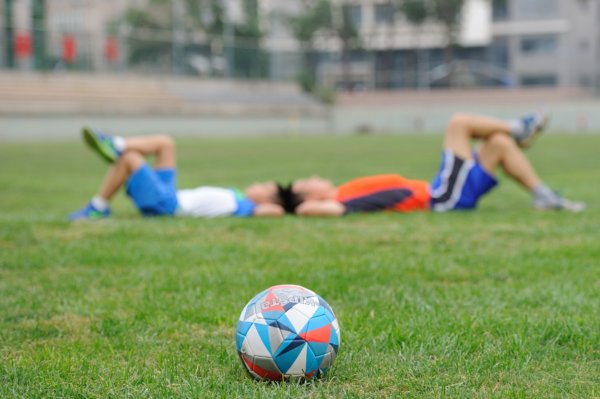Relieving Shoulder Pain
The fall sports season is here, which is common for shoulder pain.
Mobility can lead to problems with your soft tissue or bony structures in your shoulder, which often results in pain. Shoulder pain can be triggered by specific movement or be constant.
Physiotherapy provides treatment through a combination of manual therapy, stretching and electrotherapy. If you’re experiencing shoulder pain, contact us today so our physiotherapist can assess your condition and promptly start treatment to relieve your shoulder pain.
Shoulder Anatomy
Your shoulder is made up of three bones: upper arm bone (humerus), shoulder blade (scapula), and collarbone (clavicle). Several joints made up of tendons and muscles allow you to move your arm in a range of motions, from washing your hair to painting a wall.
The head of your upper arm bone fits into a rounded socket in your shoulder blade, called the glenoid. A combination of muscles and tendons keeps your arm bone centred in your shoulder socket. Tissues called the rotator cuff cover the head of your upper arm bone attaching it to your shoulder blade.
What Causes Shoulder Pain?
Shoulder problems are often related to four main categories:
- Arthritis
- Bursitis or Tendonitis (inflammation) or tendon tear
- Fracture
- Impingement and instability
Less common causes of shoulder pain include tumours, infection and nerve-related problems.
Arthritis
Shoulder pain can also be triggered by arthritis. While there are various types of arthritis, the most common arthritis in the shoulder is osteoarthritis (wear and tear arthritis). Symptoms include pain, stiffness and swelling as is common among middle-aged individuals. Osteoarthritis develops gradually with pain increasing over time.
Osteoarthritis is typically related to sports or work injury. Arthritis can be related to rotator cuff tears, infection or inflammation of joint lining.
When individuals avoid moving their shoulder to attempt reducing their arthritis pain this can lead to stiffening soft tissue which results in more pain and restricts their range of motion.
Learn how physiotherapy helps relieve arthritis pain.
Bursitis
Bursae are small, fluid-filled sacs located in joints throughout your body, including your shoulder. Acting as cushions between your bones and overlying soft tissue, they help reduce friction between gliding muscles and the bone.
Excessive use of your shoulder can lead to inflammation and swelling of bursa between the rotator cuff and part of your shoulder blade known as the acromion, resulting in a condition known as subacromial bursitis.
Bursitis often happens alongside rotator cuff tendonitis and tissues in your shoulder can become inflamed and painful. Daily tasks, such as changing your clothes can become challenging.
Learn how physiotherapy helps relieve bursitis pain.
Tendonitis
A tendon is a flexible cord connecting your muscle to your bone. Most tendonitis results from inflammation of this strong fibrous collagen tissue.
Typically, there are two types of tendonitis:
- Acute Tendonitis: Caused by excessive ball-throwing or overhead activities during work or sport
- Chronic Tendonitis: Arthritis or constant wear and tear due to aging
Learn how physiotherapy helps relieve tendonitis pain.
Tendon Tears
Splitting and tearing tendons results from acute injury or degenerative changes caused by aging, long-term wear and tear or sudden injury. Tears may be partial or completely separate the tendon from its attachment to the bone. Rotator cuff and biceps tendon injuries are most common tendon tear injuries.
Shoulder Fracture
Shoulder fractures (broken bones) typically involve the collarbone, upper arm bone and shoulder blade. Fractures usually cause severe pain, swelling and bruising above the shoulder.
Among older patients, shoulder fractures commonly result from falling at standing height.
Among younger patients, shoulder fractures are commonly caused by high-impact injury in contact sports or motor vehicle accidents.
Shoulder Impingement
Shoulder impingement occurs when the top of your shoulder blade creates pressure on underlying soft tissues when your arm is lifted above your body. When your arm is lifted, your shoulder blade rubs rotator cuff tendons and bursa which can lead to bursitis and tendonitis, causing pain and limited range of motion.
Shoulder Instability
Shoulder instability happens when the head of the upper arm bone is forced out of the shoulder socket. This is caused by sudden injury or overuse.
Shoulder dislocations can be partial or the ball of the upper arm can come completely out of the socket. Dislocations can reoccur if ligaments, tendons and muscles around the shoulder become loose or torn, causing pain and unsteadiness when you raise your arm or move it away from your body.
Repeated episodes of subluxations (partial dislocation of the shoulder joint) or shoulder dislocations can result in increased risk of developing arthritis in the affected joint.
Next Steps: Physical Assessment
A thorough examination and physical assessment is recommended to determine the cause of your shoulder pain. Our physiotherapist will assess any your swelling or inflammation, muscle weakness and tenderness, along with observing your shoulder strength and range of motion.
Shoulder Pain Treatment
Shoulder pain treatment involves rest, changing your activities and physiotherapy to improve your strength and flexibility.
If you are suffering from persistent shoulder pain, we recommend that you schedule an appointment to be assessed by our physiotherapist.
